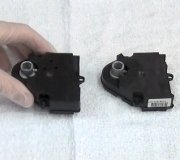There's an easy fix for the rpm problem if the battery was recently disconnected or run dead. If that is the case, it is also fairly common for fuses to blow for no reason when reconnecting the battery. There's two fuses for the radio. One is in the 12-volt switched circuit coming from the ignition switch. The other is the 12-volt memory circuit that keeps the radio presets and clock alive when the ignition switch is off. On most models that memory circuit is tied into the dome light circuit. After looking at your diagram, I see the radio memory is on the same circuit as the power mirrors, power locks, chime, and remote keyless entry module. Check if those things are working.
The ignition switch does have a history of failures but there's more to the repair than just replacing it. There's three or four separate switches incorporated into it. The part that fails is for the accessory circuit to include the radio, power windows, and heater fan. Failures are much more common for owners who are in the habit of switching the ignition switch on and off while the heater fan is set to one of its higher speeds. That's a lot of current for those switch contacts to handle. Eventually those contacts become pitted or arced. That leads to excessive resistance which translates into heat. That heat degrades the contacts further resulting in a vicious circle where the overheating gets worse and worse. That heat migrates out to the connector terminals and those two wires.
Look at your old ignition switch to see if two terminals are black or were overheated. If you see that, those two mating terminals must also be replaced. Most often the plastic connector body is melted around those two terminals. They have to be cut out along with the plastic. Use a pair of universal crimp-style terminals. Those wires will be hardened for about four inches from the heat and solder won't adhere to them. Cut away that hardened section, splice in new pieces of the same diameter, then seal those splices with heat-shrink tubing. Don't use electrical tape as it will unravel into a gooey mess on a hot day. Crimp the new terminals to the new wires, but solder them too for best connection. Plug the connector back into the switch, then plug in those two new terminals individually one at a time. If either the switch or the terminals are not replaced at the same time, the previously overheated parts will cause a repeat failure.
For the radio, start by checking the operation of the power mirrors and locks. If they do not work, suspect a blown fuse. The drawing below shows the interior "Junction Block". That's the inside fuse box. It's listed as "The fuse panel is located on the right side kick panel."
Those fuses have two tiny holes on top for test points. Use a test light or a digital voltmeter to test the two with the arrows. Here's links to some articles if you need more information:
https://www.2carpros.com/articles/how-to-use-a-test-light-circuit-tester
https://www.2carpros.com/articles/how-to-use-a-voltmeter
https://www.2carpros.com/articles/how-to-check-a-car-fuse
They're using an "auto-ranging" voltmeter in that article. That's an expensive feature you don't need. You can find a perfectly fine meter at Harbor Freight Tools for $7.00. I can help you set it up if necessary. They have a dandy test light too. You can also find those items at Walmart or any hardware store.
The blue 15-amp fuse will have 12 volts on it all the time. For the red 10-amp fuse, the ignition switch must be in the "run" or "acc" position. You should find 12 volts on both test points for each fuse. If you find 0 volts on both test points for one fuse, that circuit is not turned on. Normally that's the ignition switch we forgot to turn on. If you find 12 volts on both test points, that fuse is good. You're looking for a fuse that has 12 volts on one test point and 0 volts on its other one. That indicates it is blown. Of course you can also just pull those two fuses out and visually inspect them.
Let me know what you find. If both fuses are good, pull the radio out and read me the model number from the white paper sticker on top.
Monday, April 24th, 2023 AT 4:26 PM








